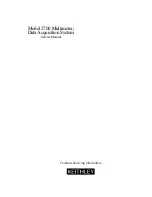
903-0628-00 Rev. 1
Model 903-HD User's Guide – FMB-X-2.5
Focal Technologies Corp.
Page 5-1
5.0 Fiber Optics
5.1 Safety
Lasers used in the Model 903 are Class I laser products. No control measures or warning labels are required,
although any needless exposure of the eye should be avoided as a matter of good practice and fiber
connectors should never be viewed with optical magnification unless all sources are disconnected.
5.2 System Design
The Model 903 fiber optic transmission system contains all the necessary transmitters, receivers, and
couplers, including WDMs and splitters, to provide a redundant fiber optic interface to a user’s cable or
umbilical.
The system is designed to work with up to two fiber optic rotary joints and up to 10,000
meters of SMF-28 singlemode fiber.
Figure 5-1: Block Diagram of Model 903 Fiber Optic Transmission System
System design consists largely of preparing a power budget as provided in the example on the following
page. System losses in decibels (dB) are summed and subtracted from the optical budget as calculated from
the difference between the transmitter launch power and the receiver’s sensitivity. Some margin, typically 3-6
dB, should be allocated for temperature and aging effects as well as degradation of the external cable and
connectors. For long cables, an additional 1-2 dB should be allowed for dispersion.
The standard Model 903 with FMB-X-2.5 cards has an optical power budget of at least 20 dB for the uplink
and downlink. Typical values are closer to 24 dB for both directions, especially for shorter cables. This budget
is applicable between the front panel connectors on the remote and console modules. Internal WDMs,
switches, splitters, and connectors are already accounted for and the full 20 dB budget is available between
the two front panel connectors when used with up to 10 km of singlemode fiber.
Return loss or back reflection is a consideration when lasers are used in high bit rate systems. For the
Model 903, the use of low return loss PC finish connectors is required for proper operation. Expanded beam
connectors with air gaps should be avoided. Total system return loss should be kept greater than 25 dB to
maximize power budget.
Kinks, tight bends, or microbending in umbilicals and tethers may cause excessive loss at 1550 nm. Ensure
that any measurements of insertion loss are conducted at both 1310 nm and 1550 nm. In some fault
conditions, measurements at 1310 nm may be fine while losses at 1550 nm are excessive.
4VID and 8VID systems use external ST/PC connectors and are acceptance tested with an uplink and
downlink power budget of 20 dB plus 10 km of singlemode fiber to provide a dispersion penalty.
Note
that the front panel transmit power and receive sensitivities for these systems typically provide a nominal
22 dB budged on short fiber links with attenuators.
Refer to the 903-8xxx-xx installation drawing for actual
power budget specifications of your system.
Содержание Focal 903
Страница 78: ...903 0628 00 Rev 1 Model 903 HD User s Guide FMB X 2 5 This page intentionally left blank ...
Страница 79: ...903 0628 00 Rev 1 Model 903 HD User s Guide FMB X 2 5 APPENDICES ...
Страница 80: ...903 0628 00 Rev 1 Model 903 HD User s Guide FMB X 2 5 This page intentionally left blank ...
Страница 86: ...903 0628 00 Rev 1 Model 903 HD User s Guide FMB X 2 5 This page intentionally left blank ...
Страница 87: ...903 0628 00 Rev 1 Model 903 HD User s Guide FMB X 2 5 APPENDIX D ISOLATION PROTECTION AND GROUNDING ...
Страница 89: ...903 0628 00 Rev 1 Model 903 HD User s Guide FMB X 2 5 APPENDIX E BACKPLANE PIN CONFIGURATIONS ...
















































